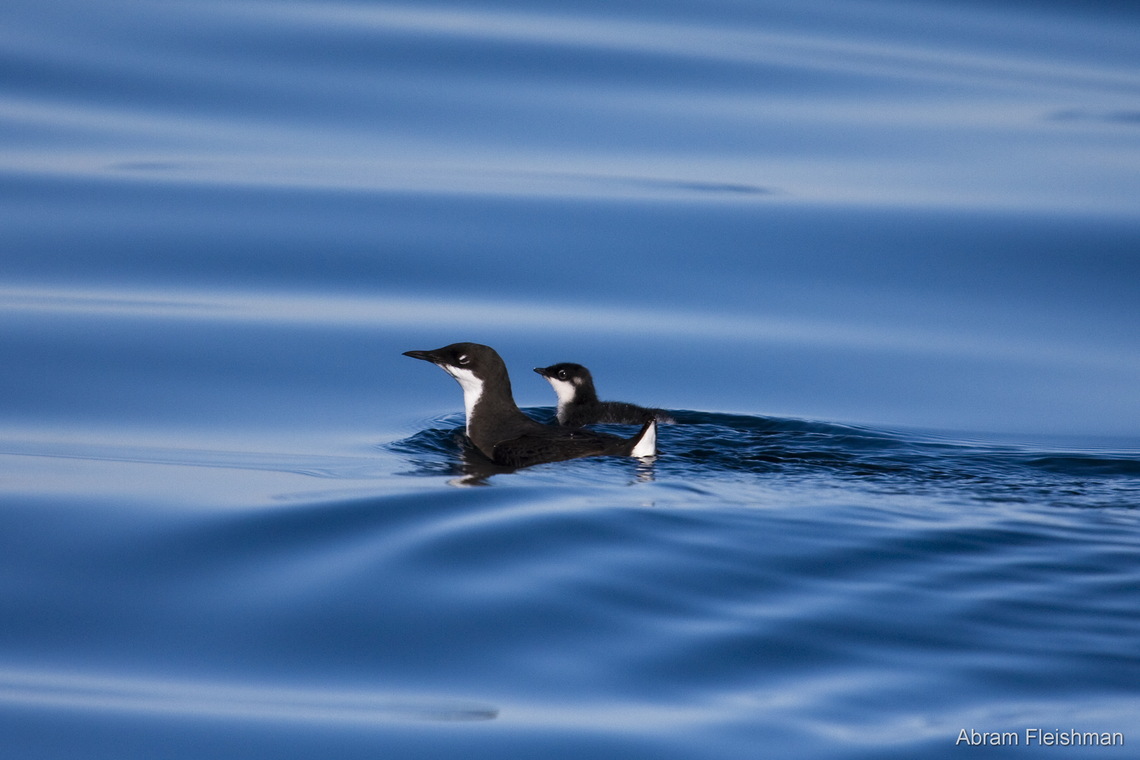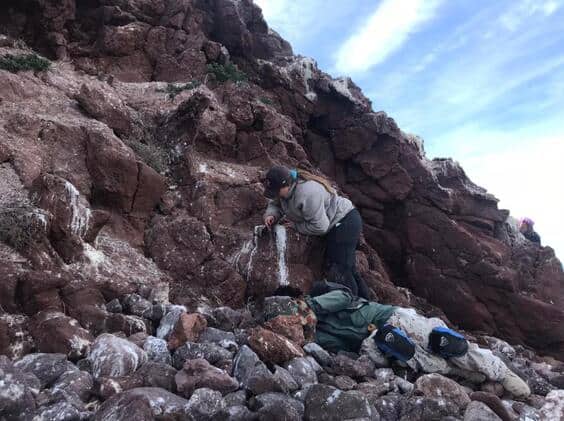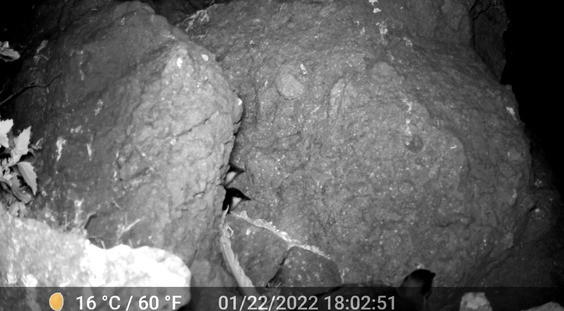
Adult Craveri’s Murrelet in the ocean with its chick (photo by Abram Fleishman).
Lauren Dolinski and Jaime Martinez, Waterbird Monitoring Program, Prescott College Kino Bay Center
The Craveri’s Murrelet (Synthliboramphus craveri) is a small and secretive alcid that occurs from the waters of southern California into northwestern Mexico. They nest in almost imperceivable cracks among the rocky shores of a few islands off the Pacific Coast and within the Gulf of California (Gulf). During the non-breeding season, they can be observed searching for food in deeper waters with their mates and chicks. The Craveri’s Murrelet (murrelet) is listed as endangered in Mexico and as such is a species of high interest for the Prescott College Kino Bay Center (the Center) in Sonora, Mexico. The Center’s monitoring efforts for this species have been increasing over the last four years. By studying the population and breeding success of this ocean dweller on select islands in the Gulf, we hope to gain a better general understanding of the species, their current population status, and insights for their current and future conservation.

Jaime Martinez and Lauren Dolinski checking the contents of an active murrelet nest and camera trap (photo by Irene Espinosa).
The Waterbird Monitoring Program at the Center has performed weekly murrelet nest checks during the breeding season for the past three years on Isla Alcatraz, analyzing the data to determine nest success. By carefully documenting which rocky crevices and small caves these birds like to nest in, we conduct weekly monitoring to track the story of each pair, and the fate of each nest. Using camera traps, we monitor when the murrelet pairs enter and leave their cavity to learn more about their breeding behavior and phenology. We have even captured video footage of chicks fledging from their nest cavity and heading off to sea, where they will be raised by their parents. Use of camera traps has been a monumental step in further understanding the behavior and habits of this species during such a vulnerable and fundamental time of their lives.

A Craveri’s Murrelet egg in an active cavity during routine nest checks on Isla Alcatraz (photo by Lauren Dolinski).
Right in the middle of the Gulf is a small, isolated island called San Pedro Mártir. Historically it was part of the breeding range for Craveri’s Murrelets. However, with the introduction of the Black Rat in the early 1800’s from human activities on the island, the murrelet population was decimated. Since the rat eradication on San Pedro Mártir Island in 2007, the Center had not performed any murrelet survey there until 2022. No one knew if the birds were going to return to the island. The Center’s first nocturnal spotlight survey and nest search in March of 2022 revealed that yes, in fact, the murrelets had returned to San Pedro Mártir and were going about business as usual – laying eggs, raising chicks, and creating new generations!
While the recovery of the San Pedro Mártir Island’s murrelet population after a rat eradication is very encouraging, the birds still have plenty of predators and challenges to worry about. While there are no rats on Alcatraz, there are House Mice that are always looking for a meal and could be drawn to eggs. In addition, avian predators are almost always nearby looking for food, such as a Barn Owl that has recently made its way to Isla Alcatraz, or Common Ravens that lurk outside cavities. The forces of nature cause chaos too. In the fall of 2022, a hurricane brought strong winds, rains, and very high tides to the islands. Later, two earthquakes took place right in the gulf. These natural disasters changed the habitat on the islands by causing rock and landslides that reshaped the shore and closed or destroyed cavities that were once used by nesting murrelets. After arriving at nest sites that are no longer accessible, the birds on Isla Alcatraz have seemed unsure about whether they will search for other suitable cavities, or simply not lay eggs this year.

Camera trap footage of two chicks fledging from their nest during the 2022 breeding season (photo by WMP, Prescott College).
While survival is not easy for a small seabird commuting from deep ocean waters to rocky island coastlines, these murrelets have demonstrated that they are resourceful and resilient when their environment allows them to be. The Center continues to monitor these birds and their populations, aiming to discover more about this species, and in turn, contribute to their long-term conservation in an ever-changing and unforgiving world.


 English
English  Español
Español